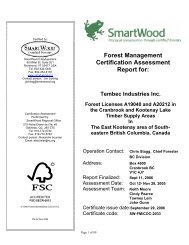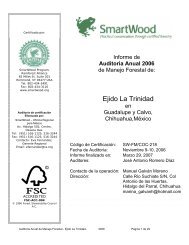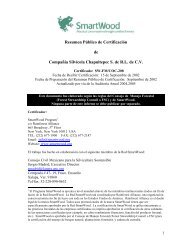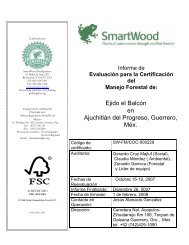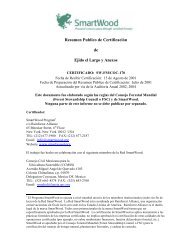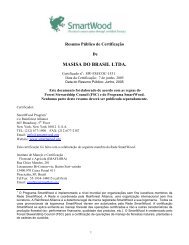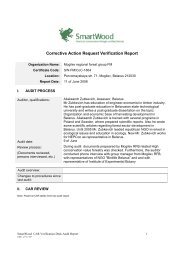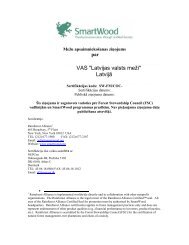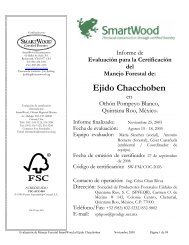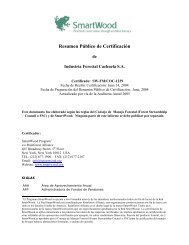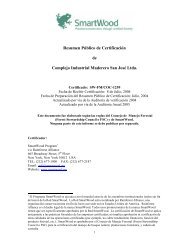Title: Rainforest Alliance/SmartWood Interim Standard for Assessing ...
Title: Rainforest Alliance/SmartWood Interim Standard for Assessing ...
Title: Rainforest Alliance/SmartWood Interim Standard for Assessing ...
Create successful ePaper yourself
Turn your PDF publications into a flip-book with our unique Google optimized e-Paper software.
PRINCIPLE # 6: ENVIRONMENTAL IMPACT<br />
Forest management shall conserve biological diversity and its associated values,<br />
water resources, soils, and unique and fragile ecosystems and landscapes, and, by<br />
so doing, maintain the ecological functions and the integrity of the <strong>for</strong>est.<br />
6.1 Assessment of environmental impacts shall be completed -appropriate to the scale,<br />
intensity of <strong>for</strong>est management and the uniqueness of the affected resources- and<br />
adequately integrated into management systems. Assessments shall include<br />
landscape level considerations as well as the impacts of on-site processing<br />
facilities. Environmental impacts shall be assessed prior to commencement of<br />
site-disturbing operations.<br />
6.1.1 Environmental assessments shall be completed during management planning.<br />
6.1.2 Environmental assessments shall consistently occur prior to site disturbing<br />
activities.<br />
6.1.3 Environmental impacts of on-site processing facilities shall be controlled (e.g.<br />
waste, construction impacts, etc.).<br />
6.1.4 Landscape level impacts of <strong>for</strong>est management (e.g. cumulative effects of <strong>for</strong>est<br />
operations within and nearby the FMU) shall be considered.<br />
6.1.5 Applicable to SLIMF FMEs only (note: above indicators do not apply) Be<strong>for</strong>e<br />
initiating any operation, the possible negative environmental impacts shall be<br />
identified and the operation is designed to minimize them. Assessments do not<br />
need to be documented unless legally required.<br />
6.1.6 FME shall ensure that planning and implementation of <strong>for</strong>est classification is based<br />
on their functions and types.<br />
6.1.7 FME shall identify the proportion of well-designed protected area (considering<br />
endangered/endemic/protected species, unique ecosystems, High Conservation<br />
Value Forests) from the total area of the FMU that should be protected; this shall<br />
be confirmed and/or recognized by all parties concerned.<br />
6.2 Safeguards shall exist which protect rare, threatened and endangered species and<br />
their habitats (e.g., nesting and feeding areas). Conservation zones and protection<br />
areas shall be established, appropriate to the scale and intensity of <strong>for</strong>est<br />
management and the uniqueness of the affected resources. Inappropriate hunting,<br />
fishing, trapping and collecting shall be controlled.<br />
6.2.1 The likely presence of rare, threatened or endangered species and their habitats<br />
(e.g. nesting and feeding areas) shall be assessed on the basis of the best<br />
available in<strong>for</strong>mation. (A list of endangered and threatened species in Indonesia is<br />
attached in Annex 3.)<br />
6.2.2 Timber species on either local and/or international endangered or threatened<br />
species lists (e.g. CITES, national lists) shall not be harvested.<br />
6.2.3 Appropriate to the scale and intensity of management, conservation zones,<br />
protection areas or other protection measures shall be established based on<br />
technically sound requirements <strong>for</strong> the protection of rare, threatened and<br />
endangered species and their habitats.<br />
6.2.4 Conservation zones should be demarcated on maps, and where feasible, on the<br />
ground.<br />
<strong>SmartWood</strong> FM <strong>Interim</strong> <strong>Standard</strong> Indonesia 2008 Page 18 of 49



